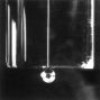THE DROPPING MERCURY ELECTRODE
31.1.2006
In the last days of war, still as soldier, he applied for PhD degree at Charles University. In course of the oral examination in physics professor B.Kučera invited the candidate to continue in studies of surface tension of mercury by the method introduced by Kučera at the beginning of the century.
The principle consisted in weighing drops of mercury falling out of a thick-walled glass capillary into a solution. The dropping mercury, connected to a source of d.c.voltage, served as one electrode, the second electrode being the layer of mercury collecting at the bottom of the vessel.
After long, tedious measurements Heyrovský found that if he measured electric current passing through the mercury drops and the solution, he obtained important information about the quality and quantity of substances contained in the solution. That information can serve chemical analysis as well as basic physico-chemical research.
Heyrovský's experimental set-up for measuring current with the dropping mercury electrode: A - source of d.c.voltage, K - variable ohmic resistance as potentiometer, V - voltmeter for checking the d.c.voltage, Rp and Rs - peg resistors for control of sensitivity and damping of the mirror galvanometer G measuring the current, L - lamp for illuminating the mirror of the galvanometer by reflection from which a luminous spot is produced on the scale S , Z - cell containing the examined solution and the mercury electrodes - the dropping and the stationary one which keeps its potential constant.

Jaroslav Heyrovský
- YOUTH
- THE DROPPING MERCURY ELECTRODE
- UNIVERSITY PROFESSOR
- THE POLAROGRAPH
- NOBEL PRIZE FOR POLAROGRAPHY
- POLAROGRAPHY AT THE BEGINNING OF 21ST CENTURY

Jaroslav Heyrovský
- YOUTH
- THE DROPPING MERCURY ELECTRODE
- UNIVERSITY PROFESSOR
- THE POLAROGRAPH
- NOBEL PRIZE FOR POLAROGRAPHY
- POLAROGRAPHY AT THE BEGINNING OF 21ST CENTURY



